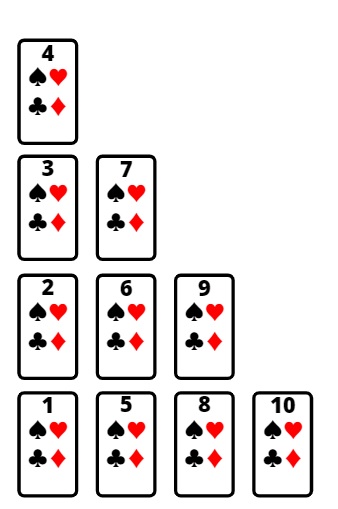In this article, I am going to introduce a new card spread to use with playing cards. Throughout this article, I will break down the inspiration for the card spread and explain how to perform it. The result will be something new called Opening the Devil’s Triangle.
The inspiration
A goal of this blog is to look at gaming elements within the context of divinity. I play beat the devil, a solo card game for Youtube content. I have gone as far as using tarot cards to play beat the devil to cast fortunes with great results.
Recently I read the book Old Style Conjure: Hoodoo, Rootwork & Folk Magic by Starr Casas. A card spread described in the book inspired me for this new reading method.
The card spread found in Old Style Conjure is the Holy Trinity Crossroads Spread. It uses a four-row pyramid with 10 cards. In each row, one card is added to make up 10. The spread has a reversed form with the pyramid shape upside down. I chose to borrow the pyramid structure for this card spread.
Beat the Devil With Ten Piles
When playing beat the devil you can increase your odds of winning by having more available piles to use. The more card piles you have available, the better chances you have of winning with a 52 card deck.
The original rules allow eight piles to use in the game. With those rules, you can win roughly 9-12% of the time, or between 7 and 10 attempts. Sometimes it takes even more attempts to win a game.
Using modified rules to beat the devil we can allow for 10 cards. There is a sweet spot for the game at around 10 piles. You can win far more often, but there is still a chance of losing.
This game element will serve as a way to deliver the cards into the spread with a sense of controlled chance.
Building the Spread
The cards are built up in columns instead of rows to make the triangle. The first column is one card, two, three, then four to make the triangle. When we reverse the spread, we reverse the order of cards. Build a column of four, then three, two, and one final card.
Note: when building the columns start from the bottom upwards before moving to the next column.
Reading the Columns
George Polya’s problem-solving techniques offered a clear four-step approach for solving problems. I used Polya’s four steps to problem-solving from the 1945 book How to Solve It to come up with my own four steps.
There are two versions of this card spread.
Opening the devil’s triangle will allow you to expand on a situation or question to get a better understanding of it. The reversed form of it is closing the devil’s triangle. This form will help you focus on a definite answer.
Opening the Devil’s Triangle

The first column (1 card): Your situation. This represents you right now. It defines what it is you are attempting to understand.
The second column (2 cards): Understanding the Situation. What do I need in order to understand to move forward?
The third column (3 cards): Moving Forward. What steps are going to available to move forward with?
The fourth column (4 cards): The Result. What is the result of having moved into new directions, and where does it leave you now?
Closing the Devil’s Triangle

The first column (4 cards): What I know. What can I do to simplify what I know.
The second column (3 cards): Understanding what I know. What do I need to understand to move forward?
The third column (2 cards): Moving Forward. What steps are going to available to move forward?
The fourth column (1 card): The situation. This represents the situation you are placed in having accepted all the new directions given through the cards. The last card should be able to give closure on what is being asked. If you have not received appropriate clarity try the spread again.
If you are struggling with something I recommend closing the devil’s triangle. It will reduce the complexity of it into a simple answer. If you are looking to expand your knowledge on a question chose to open the devil’s triangle to reveal more.
Performing the spread.
Think of the question you wish to open or close the devil’s triangle with. Preform a riffle shuffle while you meditate on the question. Preform 7 shuffles. This will put the deck into random order. If you want to learn more about randomness in cards read this article.
Now draw the cards according to the rules of beat the devil.
The rules for beat the devil have been changed to fit the context of this reading. To learn more about the original rules read more here.
The modified rules of beat the devil are:
- You have 10 piles to form a triangle of four columns.
- The first column is one card, the second is two, the third is three, and the fourth is four.
- Build the pyramid upwards in both cases of opening or closing the triangle.
- Draw the first card from the top of the deck.
- Draw the next card according to how the triangle is built.
- If the two cards match draw one card on top of each of the cards.
- If those two cards do not match then draw another card to make the next pile.
- You cannot draw a card into a new pile until you have covered all available matches.
- When drawing cards you cannot make any matches until you have covered the target matches.
- You will witness multiple match possibilities, or even three, or four of kind. You will have to choose which matches to cover before opening a new pile.
- Keep drawing cards for matches or create new piles within the triangle until you run out of cards.
- If you run out of cards you have completed the triangle successfully.
- If you still have cards left, have used up all ten piles, and you can’t make any more matches then you have
- been unsuccessful.
NOTE: You will have to make sure you create ten piles of cards to complete the card spread.
If you are doing well at creating pairs, and have not created ten piles, make sure you save a few cards for the end. How this works is simple. Look at what pairs you can make and then look at how many cards are left. Cover what you can and create the remaining piles to make ten.
If you have been unsuccessful in using the whole deck then you should already have the ten piles needed for the reading.
Watch this demo video to for a walking though in how to preform this card spread.
This video will demonstrate a full reading using the card spread.
Your Success
Your success in creating the triangle is a good sign for all the cards in the spread. It can mean the result of the reading will have positive results.
If you have been unsuccessful in building the devil’s triangle, then take that as a sign of some blockage. It could mean that you didn’t focus your intention enough on the reading. Try to focus more, ask a different question, or try the opposite spread. Treat the success of the game part of the spread as a subtle divine layer for the cards.
Reading the Cards
Use the rules above to know what each column means. Then interpret the meaning of the cards in conjunction with the cards around it, use this article to look up the meaning.
If you have a negative card, see what cards surround it. Attempt to resolve the negative meaning through positive cards. Try not to focus on only one card. Use all the cards to generate a holistic meaning. Build a story for yourself. The rules are set up in such a way that it guides you.
Concession to the Rules
I recommend that you take your time with this reading. Appreciate how the cards appear and use that time to meditate on your question. You have the power to influence them as you have the power to influence how your life unfolds.
If you are short on time you can forgo the beat the devil section. In this case, draw out 10 cards according to the shape of the triangle, and read the cards. Doing this will give you a quick reading if you are short on time.
This concludes the rules of Opening the Devils Triangle.
Everyone seems to have a playing cards lying around. Next time you see one. Play beat the devil or use this spread and see what it tells you. It takes only a few minutes. Enjoy, and good luck!
Use the link here to look up the meaning of the cards.
If you want to more about the odds of winning beat the devil you can go here too.
References:
https://en.wikipedia.org/wiki/How_to_Solve_It
Casas, Starr. Old Style Conjure: Hoodoo, Rootwork & Folk Magic. Newburyport: Weiser Books. 2017. Print.


